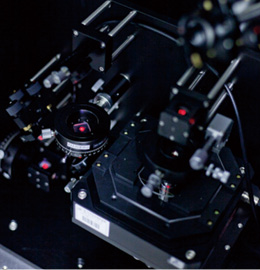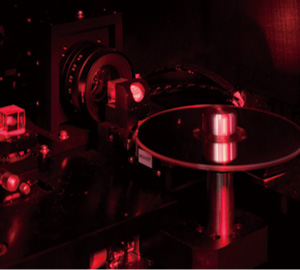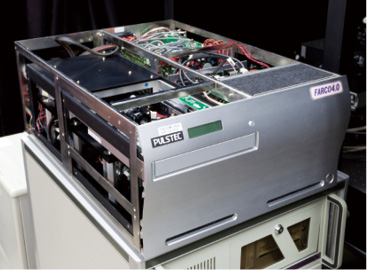OPAL-RING
Eriko WATANABE Laboratory
Study of Optical Computers Integrating Photophysics and IT Technologies and Precise Measurement
| Faculty/Department | Department of Engineering Science Graduate School of Informatics and Engineering |
|---|---|
| Members | Eriko Watanabe, Assistant Professor |
| Affiliations | Japan Society of Applied Physics, Optical Society of Japan, Laser Society of Japan, Information Processing Society of Japan, Society of Academic Study on Sensing via Image Information |
| Website | http://mp-image.f-lab.tech.uec.ac.jp/ |
As of August, 2015

- Eriko WATANABE
- Keyword
-
Optical information processing, optical correlation, optical interferometry, holography, digital holography, 3-dimensional measurement, optical memory, optical computing, image recognition, holographic memory, multimedia search, external inspection, pathological examination, analysis of cell information
Summary of Research
Integrating Photophysics and IT Technologies
With the transition from 32-bit to 64-bit CPUs and from single-core to multicore processors, the speed and capacity of computer hardware have advanced dramatically. Memory data rates have made dramatic strides as well, from 1 GBps in the days of SDRAM to an astonishing 17 GBps in the latest DDR3 memory units. In striking contrast, improvements in readout times from hard disks have been disproportionately modest, creating a bottleneck to progress in overall computing performance and preventing full exploitation of high-performance CPUs and memory units.<br /> Resolving this bottleneck will require a breakthrough that establishes an entirely new hardware paradigm. One solution is optical computers. New optical technologies allow us to achieve ultra-high transfer rates of up to several 100 Gbps while simultaneously performing correlation calculations.<br /> Combining photophysics and the latest IT, information processing, and control technologies, our laboratory is currently pursuing three research themes, with the goal of building novel optical computing and optical measuring systems.
A New Microscope System That Makes Phase Measurements at Nanoscales

- High-precision, high-speed phase measurement device
The first theme targets advanced medical fields and device inspections. We are currently undertaking a study on a new microscope system capable of phase measurements of transparent media such as living cells at nanoscales. We first articulated this particular research theme when we realized that a characteristic of holography, the ability to instantaneously capture an image of 3-dimensional objects, presents the potential for extracting microstructures.
This system obtains the complex amplitude distribution of light waves by optical interferometry and presents it in 3-dimensional format. The spatial resolution achieved by this method is around 600 nm. The visualization scheme provides an optical path length resolution of about 2 nm, making it possible to visualize changes in the long-wavelength region exceeding wavelengths of 3 μm. This in turn makes it possible to acquire measurements at the scale of cell thicknesses, a powerful capability beyond conventional systems. Potential applications for this ultra-high precision, high-speed phase measurement instrument include tasks in advanced fields of medicine, including quality control of living cells for regenerative medicine and cancer screenings and inspections of transparent substrate materials, such as the glass and resin used to make touchpanels.
Ultra-High-Speed Search Engine for High-Capacity Image Data Using Optical Computing
Our second research theme involves an ultra-high speed search engine for high-capacity image data based on the functions provided by optical computing. This system would allow a full search of giant databases, as well as rapid verification of high-capacity data against massive video data files. A recent focus in our efforts to find applications for this system is high-speed image searching on the Internet. Countless video files are currently being uploaded daily to the Internet, despite the slow progress by standardization bodies in setting helpful standards.<br /> Our ultra-high speed search engine technology for high-capacity image data makes it possible to perform a rapid search of uploaded content. For example, our unique algorithm extracts the most representative portion of a targeted feature image from video data and encodes it into a black-and-white image. Prior to this, the encoded image data had been entered into the database simply as video data. When the target data is superimposed on the video data in the database and light is transmitted through the superimposed images, the strongest signal is issued when the characteristics of the two images match.<br /> This criterion can be used to search through the database, a task ideally suited for optical computing. This is the key feature of our image processing system.
Design and Measurement of Opto-Functional Devices

- Inside a computer incorporating a holographic disc
The third research theme at our laboratory involves the design and measurement of opto-functional devices associated with optical computing. The findings from our research have resulted in some of our most remarkable advances.
Advantages
Applying Phase Measurement Technologies for Noncontact and Noninvasive Analysis of Transparent Objects
Our measurement technologies using optical technologies employ radical new methods that permit noncontact and noninvasive measurements and eliminate the need for pretreatment. Our system makes it possible to inspect cells before transplantation, a capability that will revolutionize quality control procedures for living cells.
Regenerative medicine involves the cultivation of the patient’s own cells. Once dyed, however, cultivated cells become unfit for transplantation. No available technology allows noncontact and noninvasive inspections. Cells cultivated for transplant and those cultivated for inspections must be cultivated separately. The actual transplanted cells are not inspected, raising certain risks.
Image Search Engine, Holographic Memory, Optical Computing
With the ultra-high speed search engine for high-capacity image data developed by Assistant Professor Watanabe, data is stored as image data for extremely high-speed computation and verification. The data storage system lacks hard disk drives; instead, it uses a special memory scheme compatible with 3D recording media, called holographic data storage, which records information throughout the volume of the media.
In the system proposed, a disc having the same dimensions as a CD is fabricated from a holographic material. This disc allows data verification at rates equivalent to several hundred Gbps by allowing a laser beam to create an interference pattern directly on the data disc. Based on an optical technology that departs radically from technology used by existing computers, this system has the potential to resolve the bottleneck problem discussed above.
The current research on applied optical computing by Assistant Professor Watanabe is among the most advanced studies of its kind in the world.
A Compact, 4th-Generation Rack-Mount Server and Cloud Service
This technology has already launched a business venture, and work to create the model designed by Assistant Professor Watanabe has been completed, as well as the procedures for developing the associated software. Based on a compact, 4th-generation rack-mount server, this image search system has been developed into a commercial product. We plan to continue R&D efforts to develop a low-cost high-performance system that’s even smaller
The sophistication embodied in the software derived from our R&D has led to its deployment by several businesses in the cloud computing environment. Eventually, we hope to incorporate the image search device into the optical computer currently being developed to enable faster, large-volume image processing.
Industry-University-Government Collaboration and Support

- FARCO (Fast Recognition Optical Correlator) IV
Several projects are vigorously pursuing work based on the studies above. Through the Target-driven R&D (A-STEP) program of the Japan Science and Technology Agency (JST), a proposal entitled “Analysis of Cell Information and Cell Identification Using High Precision Phase Measurement” has been selected as a project within the Adaptable & Seamless Technology Transfer Program. We have received funding support from JST since the 2012 academic year. In the 2013 academic year, we obtained a grant for the Ring! Ring! Project of the Japan Keirin Association (JKA) for research and development efforts related to a project entitled “Subsidiary Research on and Development of the Phase Measurement System.”
Future Prospects
Finding Killer Applications
While remaining true to her identity as scientist pursuing research on photophysics, Assistant Professor Watanabe takes the perspective of an engineer when seeking applications for her findings. She hopes to use her insight as a photophysics expert to find as many compelling applications as possible. Plans call for promoting the commercial introduction of the technologies currently being studied, including phase measurement technologies at nanoscales, image processing technologies, and the ultra-high speed search engine for high-capacity image data.
